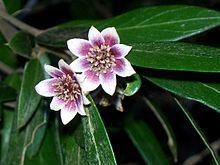Rank Subspecies | Genus Atherosperma | |
 | ||
Atherosperma moschatum subsp. integrifolium is a small evergreen tree native to the temperate rainforests of central and northern New South Wales, Australia. In 2006, it was recognised as a separate subspecies by Richard Schodde. Common names include "southern sassafras - narrow leaf form" and "blackheart sassafras".
Contents
Distribution
It is found in four areas: Monga National Park, Blue Mountains, Barrington Tops, and at Mount Grundy west of Port Macquarie, by streams such as the Tia River. It may also be undiscovered in the Illawarra to the south, and New England National Park to the north. The original specimen was collected in the Blue Mountains.
Genetic study
Genetic studies of the subspecies, along with the more widespread southerly distributed subspecies, Atherosperma moschatum subsp. moschatum, have shown that populations of the subspecies A. m. integrifolium are the most strongly diverged of all populations within the range of the species at both isozymes and chloroplast DNA. These results are consistent with long-term isolation of these populations through at least the last glacial period.
Habitat
Its habitat is cool, moist, protected areas, ranging from 650 to 1540 m above sea level, near streams. Almost always it is seen growing with the black olive berry. Often found on the richer volcanic soils, it also grows in sandstone slot canyons where it may be in a dwarf form. An uncommon or rare plant, it may be seen at the Mount Tomah Botanic Garden west of Sydney, or on the Neates Glen walk at Blackheath.
Description
The southern sassafras is a shrub or a small tree, growing from 1 to 30 m tall. The trunk is not buttressed and somewhat cylindrical. The bark is fairly smooth with bumps and lenticels, often also marked with moss and lichen. Young shoots and new growth are noticeably hairy. It is a scented and beautiful tree, especially when in flower.
Its leaves are narrower than the more southern form of A. m. subsp. moschatum, and many of the leaves are entire, though some small prickles grow on a minority of leaves. Leaves are opposite on the stem, 8 cm long, 1 cm wide, white underneath, glossy above, and veiny. They are pleasantly scented when crushed.
Flowers and regeneration
Flowers form in winter, facing down to avoid rain and snow. Petals are white, and yellow and maroon in the centre. The fruit capsules mature and open around January, releasing feathery wind-blown seeds. Germination is unreliable. However, abundant new seedlings may unexpectedly form. Seedlings are unlikely to survive at lower altitudes.
